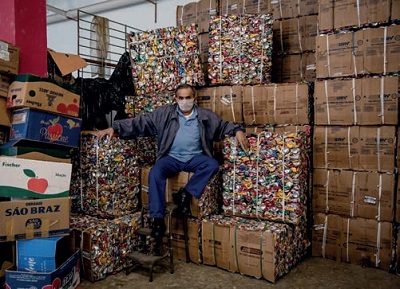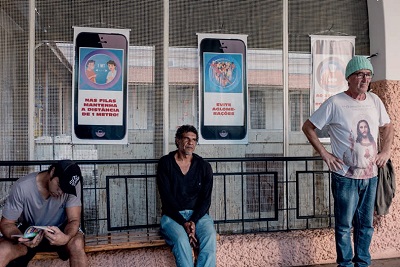Quarantines
Publish date 11-10-2020
 A train of the São Paulo Railway Company, loaded with Italian immigrants, cuts through the forests of the sea chain, which separates the coast of Santos from the Paulista plateau. After weeks of travel stacked in the hold of two European steamers, tossed about by the Atlantic, dejected and in poor hygiene conditions, they know nothing of what awaits them, but some health authorities of the new homeland have already made a decision about their immediate fate.
A train of the São Paulo Railway Company, loaded with Italian immigrants, cuts through the forests of the sea chain, which separates the coast of Santos from the Paulista plateau. After weeks of travel stacked in the hold of two European steamers, tossed about by the Atlantic, dejected and in poor hygiene conditions, they know nothing of what awaits them, but some health authorities of the new homeland have already made a decision about their immediate fate.
It is June 5, 1887. The newspapers of São Paulo - a gestating metropolis, already expanding due to the coffee economy - announce cases of smallpox among the guests of the dilapidated government building in the Bom Retiro district, where the new arrivals are headed. Here is the dilemma: risk the rapid and probable contagion of that human load or take them somewhere else? The decision was made: the train will have to continue to the new reception center, still under construction, in the suburb of Brás. Those 800 exhausted human beings will have to settle in dormitories still without beds and with a limited number of latrines, but at least they will escape that contagion.
The sudden hijacking, due to the risk of an epidemic, unofficially inaugurates what will become the historic Hospedaria de Imigrantes, the Paulista Ellis Island, one of the most significant places in Brazilian history of the last 130 years, not only because 2.5 million emigrants will pass there, which will literally change the face of the country, but also because the management of this gigantic and uninterrupted flow of human beings will continuously intertwine with the history of national public health, in a certain sense, up to the Covid-19 pandemic, compared to which Brazil is the 2nd most affected country in the world.
 Hospedaria in quarantine yesterday
Hospedaria in quarantine yesterday
The perimeter walls of the large complex of the Hospedaria de Imigrantes were finished a few months later. Over the years, that perimeter of railings and exposed bricks would become not only the fleeting border between the inhabitants of São Paulo and those waiting to become one, but also between infected and healthy, between quarantined and not, between hope and despair.
In addition to providing food and accommodation, registering documents and acting as an employment office serving the coffee farms, the Hospedaria also functioned as a health center. As soon as they arrived - in addition to personal hygiene, disinfection and change of clothes - immigrants were visited by a doctor and received the first vaccines against the diseases that plagued Brazil at the time and to which the new arrivals were not immune.
After yet another smallpox epidemic, it was the turn of the bubonic plague and, in 1889, of a new epidemic of yellow fever. When, in 1918, the Spanish pandemic, one of the deadliest events in history, broke out, São Paulo was also seriously affected. A structure like the Hospedaria, built to receive up to 3,000 people, needed adequate measures to prevent diseases - which also caused numerous deaths inside the structure - from beyond its walls.
One of the most used resources was the quarantine. If for many - veterans of the ongoing Covid-19 pandemic - this word recalls the experience of a shared apartment, of a house outside the door, alone or in company, but in any case a tiring "locked in", let's imagine what it could mean a quarantine between the 18th and 19th centuries, after tremendous weeks of travel, dreaming of a new life, but also fearing it: new language, new climate, new food, new work contract, in a mentality still shaped by the slavery regime.
As happened in other centuries and in other contexts, but with peculiar characteristics in the case of Brazil, foreigners, the poorest and above all African slaves - who once "free", but abandoned to themselves themselves, inevitably ended up inaugurating the favelas - they were easily stigmatized as dangerous carriers of disorder and disease, actually being the main victims.
On this plot, we can see deep lines of continuity between that Brazil at the end of the 19th century - the last country in the New World to abolish slavery, in 1888 - and Brazil in 2020 afflicted by coronavirus, where the poorest and, among them, the indigenous people and an overwhelming black and mestizo majority of the suburbs, find themselves facing already insurmountable, and now exasperated difficulties in following the measures of confinement: a faleva? How is it possible to "stay at home" if you don't have a home?
 Hospedaria in quarantine today
Hospedaria in quarantine today
Among the different realities that in Brazil have found themselves having to answer these dramatic questions directly is Sermig which in the immense San Paolo operates through the Arsenale della Speranza, born in 1996 right between the the historic Hospedaria de Imigrantes del Brás, now abandoned and semi-uninhabited.
Thanks to the commitment of Italian and Brazilian missionaries and volunteers, the ancient gate, which had watched over the transit of millions of immigrants, reopened to receive the "people of the street", the so-called "moradores de rua", young people and adults who work in the submerged to scrape together something and have only a piece of cardboard to spend the night on. To date, over 63,000 people have been welcomed at the Arsenale della Speranza - 1,200 a day - but in these 24 years no one would have imagined that one day the ancient health function of this space, which has remained dormant over time, would also be reactivated: quarantine.
When the missionaries of Sermig learned of the first case of contagion ascertained by Covid-19 in Sao Paulo - which remains the main epicenter of the pandemic in Brazil - it was immediately evident that the guests of the Arsenale della Hope they could not have respected any of the recommendations given by the WHO, starting with that of staying at home, simply because they do not have a home in which to spend an entire day. The recommendations that the world is giving to defend itself from the coronavirus are, in fact, aimed at certain social classes. From a certain level down, unfortunately, they are impractical. The disease is common to everyone, but prevention and access to medical care are not.
As in the past - faced with the risk of an epidemic that had unofficially inaugurated the Hospedaria de Imigrantes - the Fraternity of Sermig also found itself faced with a dilemma: to rely on compassion, which Has this project always been moved or temporarily close the reception service, so as not to risk that the large house of the Arsenale becomes a "biological bomb" for spreading the virus? Historical assonances and resonances...
And here is the decision: to transform the Arsenal of Hope into a quarantine, 24 hours a day, 7 days a week. On 23 March 2020, as the long line of 1,200 guests entered, social workers and educators gathered them in groups: «Gentlemen, to try to protect us from contagion, starting today those who enter remain there indefinitely. The health authorities say that the new coronavirus is a threat to life and, therefore, the best thing to do is to stay at home, day and night in the Arsenal.»
Over 1,000 people remained. Literally, a people. Although large, the Arsenal had to reinvent, transform, change pace to allow hundreds of men - who normally spend the day as "urban nomads" - to settle in one place, eat, sleep, take care of personal hygiene and many other issues that have now become of fundamental importance.
Since 23 March, the Arsenale has used all the resources to guarantee extra food for guests and set up a long series of tricks and activities to spend the day, creating the conditions for the quarantine to last over time: assembly of tensile structures to guarantee covered and ventilated environments, meeting rooms transformed into a deposit for donations, triage stations outside for social workers, over 200 thousand meals served (including breakfasts, lunches and dinners) ...
An enormous effort that required and received solidarity and the concrete help of dozens of individuals, associations, social organizations, solidarity groups that supplied the Arsenale and its inhabitants with basic foodstuffs, kits for 'personal hygiene and cleaning products ... a positive and encouraging sign of a civil society that, in addition to helping, also plays a significant role as a bridge between "separate worlds" within rno of the same city.
 Hospedaria in quarantine, and tomorrow?
Hospedaria in quarantine, and tomorrow?
In Brazil, the coronavirus has already caused over 110,000 deaths, more than 3.5 million confirmed cases of contagion and the loss of 1.5 million jobs, without the pandemic peak having yet been reached and in the midst of a fierce political war between the Central Government and the States of the Faith ¬ ration that generates uncertainty and fear. No one today is able to predict the extent and the final outcome of this crisis.
As for the Arsenale della Speranza, more than 5 months have already passed since the beginning of this new and, in a certain sense, historical "mass quarantine" , a sort of last ring formed on the old trunk of the Hospedaria de Imigrantes. The toll, for now, is of no serious health picture and no confirmed case of Covid-19.
Not even the Arsenal is able to predict how this story will end ... but if we can draw a conclusion, albeit provisional, perhaps we can say that in front of a problem, especially if it has the face of a person or a community in difficulty, it is not enough to offer "something", a makeshift solution, we must give the best we can, reaching the heart of the problems, to continue to give hope to everyone.
Simone Bernardi
NP August / September 2020





